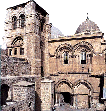The Church of the
Holy Sepulchre has been known by tradition along with evidence
of the centuries to stand over the locations of Golgotha, the
hill of the crucifixion, and the tomb of Jesus Christ.
The first descriptions of
the location come from the Holy Gospels themselves. The
specific points mentioned are that the location is located in a
quarry located outside of the city walls, His
body then placed within a newly rock-cut large tomb located
nearby the hill of Golgotha and laid upon a rock shelf cut in
the right side of the tomb. Archeology has proven that the
current site fulfills all of these descriptions:
The entire area around the
church has been consistantly proven as having been used as a
quarry previous to the first century. Not far from the tomb of
Christ lies two additional unmodified tombs carved into the rock (this is currently
known has the tomb of Joseph of Arimathea) that date from the
first century.
The quarry and tombs
sat outside of the first and second walls of Jerusalem at the
time of the crucifixion of Christ. The third walls, not erected
until 41-44, would finally extend Jerusalem to include the
area. Recent archiological finds of remnants of the second wall
show that the area of the Holy Sepulchre clearly sat outside of
the city walls at the time of Christ, ending speculation
(primarily during the 19th century) that the area was within
the walls of Jerusalem at the times of the events and therefore
not the viable place.
Historical evidence
through pilgrimages to the site over the last two thousand
years have given us many testimonies that the current edicule
stands over a large rock-cut tomb with a bench for a body on
the right side. Recent excavations using modern technology
indicate that not only is it possible the current edicule (the
fourth built here) may still holds parts of previous edicules
erected here, but at the center of them the rock-hewn shelf and
at least part of at least two of the rock walls likely still
stand today underneath the cladding of the edicules.
Within the church is
located a drawing of a ship
dating from before 125 with the words “Lord, we have
gone” indicating pilgrimages to the site before the
entire area was to be covered over in 125 with a Roman temple
built by the emperor Hadrian. In 325 when this Roman structure
was demolished on the order of the emperor Constantine,
historian Eusibius states "...as soon as the
original surface of the ground, beneath the covering of earth,
appeared, immediately and contrary to all expectation, the
venerable and hallowed monument of our Saviour's resurrection
was discovered. Then indeed did this most holy cave present a
faithful similitude of his return to life, in that, after lying
buried in darkness, it again emerged to light, and afforded to
all who came to witness the sight, a clear and visible proof of
the wonders of which that spot had once been the scene, a
testimony to the resurrection of the Saviour clearer than any
voice could give".*. Cyril, later
Bishop of Jerusalem, also present not only lists the cave
found, but also a hollowed out shelter in front of the tomb
containing the stone used to seal the tomb.
Ancient traditions
and recent evidences all seem to show that the current location
of the Church lies over the tomb of Christ and Golgotha. Dan
Bahat, former city archeologist of Jerusalem, states
“We may not be absolutely certain that the site of the
Holy Sepulchre Church is the site of Jesus’ burial, but
we certainly have no other site that can lay a claim nearly as
weighty, and we really have no real reason to reject the
authenticity of the site”
